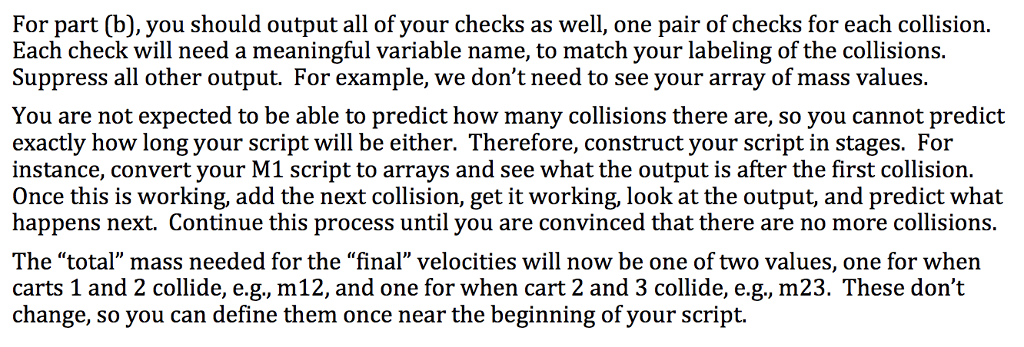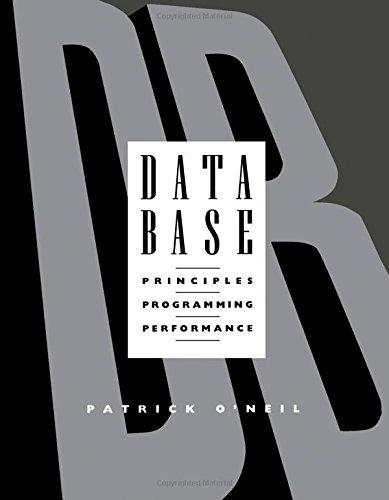

Exercise M3 Let's add one more cart, change the values here and there, and see what happens. As before, all collisions are elastic. 30cm/s_ 15cm/s 45cm/s 240g 120g 360g (a) How many collisions will there be in all? How do you know? Explain (b) Show that both momentum and energy are conserved after each collision. (c) What are the final velocities of the three carts? You must use arrays and dot operations, which will make your script more compact and streamlined. However, you may NOT use functions or loops. (We will use these later.) Label the carts 1, 2, and 3, from left to right. Define an array of three masses and an array of three initial velocities. Compute the total momentum and total energy initially in the system using dot operations and the SUM command. (This will be MUCH simpler than what you needed to do previously.) Decide which collision will happen first, and use the formulas from exercises M1 and M2 to predict the two new velocities afterwards. You should end up with a new array of three velocities. Compute the total momentum and total energy, and compare it to the initial values in order to check momentum and energy conservation. (And don't forget that a proper check returns zero, if at all possible.) Now, decide which collision happens next. One of the "final" velocities from the previous collision now becomes an "initial" velocity for this collision. Repeat the calculations and checks Repeat this process until there are no more collisions. How do you know? Explain your thinking As part of your explanation for part (a), output the array of velocities after each collision. In eaclh array, it is understood that the first element is the velocity of the left cart, the second element is the velocity of the middle cart, and the third element is the velocity of the right cart, so you never need to "unpack" the arrays. Think about the names you will use for these arrays to make thenm meaningful to someone who is reading the output. For instance, because the carts are labeled 1, 2, 3, which serve also as array indices, you might want to label the collisions a, b, c, etc. Outputting the last velocity array will answer part (c) Exercise M3 Let's add one more cart, change the values here and there, and see what happens. As before, all collisions are elastic. 30cm/s_ 15cm/s 45cm/s 240g 120g 360g (a) How many collisions will there be in all? How do you know? Explain (b) Show that both momentum and energy are conserved after each collision. (c) What are the final velocities of the three carts? You must use arrays and dot operations, which will make your script more compact and streamlined. However, you may NOT use functions or loops. (We will use these later.) Label the carts 1, 2, and 3, from left to right. Define an array of three masses and an array of three initial velocities. Compute the total momentum and total energy initially in the system using dot operations and the SUM command. (This will be MUCH simpler than what you needed to do previously.) Decide which collision will happen first, and use the formulas from exercises M1 and M2 to predict the two new velocities afterwards. You should end up with a new array of three velocities. Compute the total momentum and total energy, and compare it to the initial values in order to check momentum and energy conservation. (And don't forget that a proper check returns zero, if at all possible.) Now, decide which collision happens next. One of the "final" velocities from the previous collision now becomes an "initial" velocity for this collision. Repeat the calculations and checks Repeat this process until there are no more collisions. How do you know? Explain your thinking As part of your explanation for part (a), output the array of velocities after each collision. In eaclh array, it is understood that the first element is the velocity of the left cart, the second element is the velocity of the middle cart, and the third element is the velocity of the right cart, so you never need to "unpack" the arrays. Think about the names you will use for these arrays to make thenm meaningful to someone who is reading the output. For instance, because the carts are labeled 1, 2, 3, which serve also as array indices, you might want to label the collisions a, b, c, etc. Outputting the last velocity array will answer part (c)








